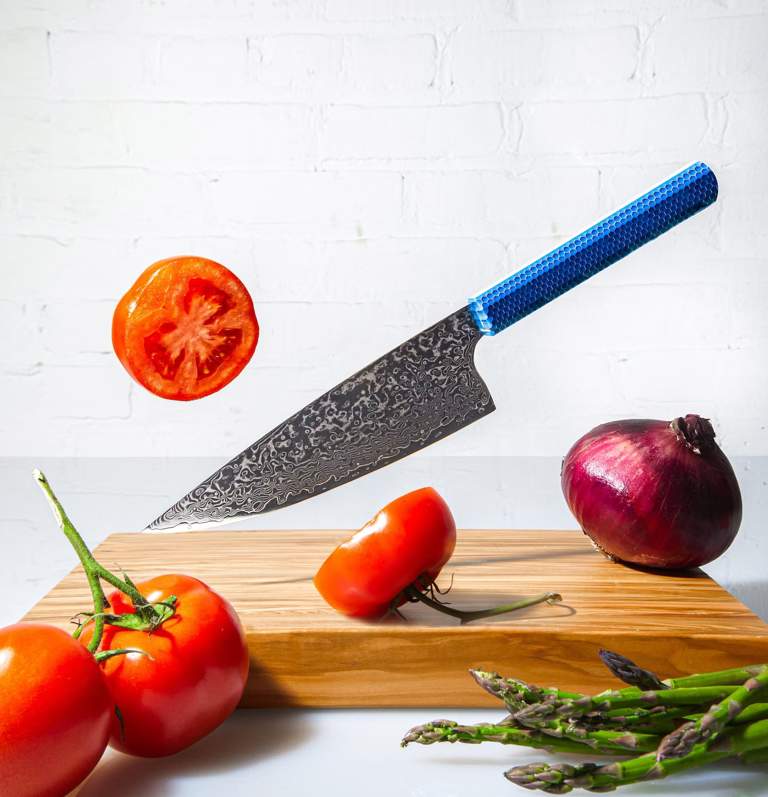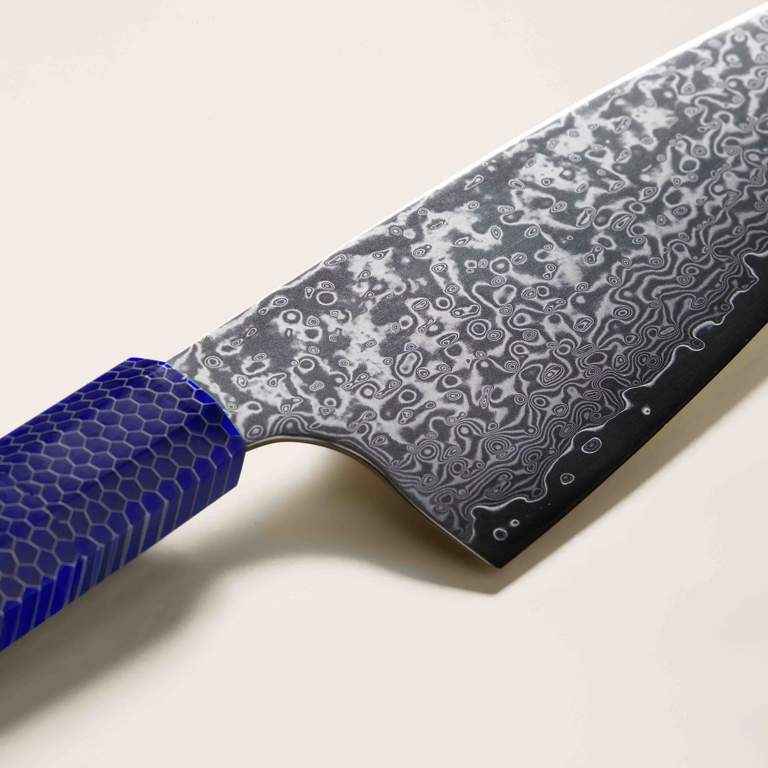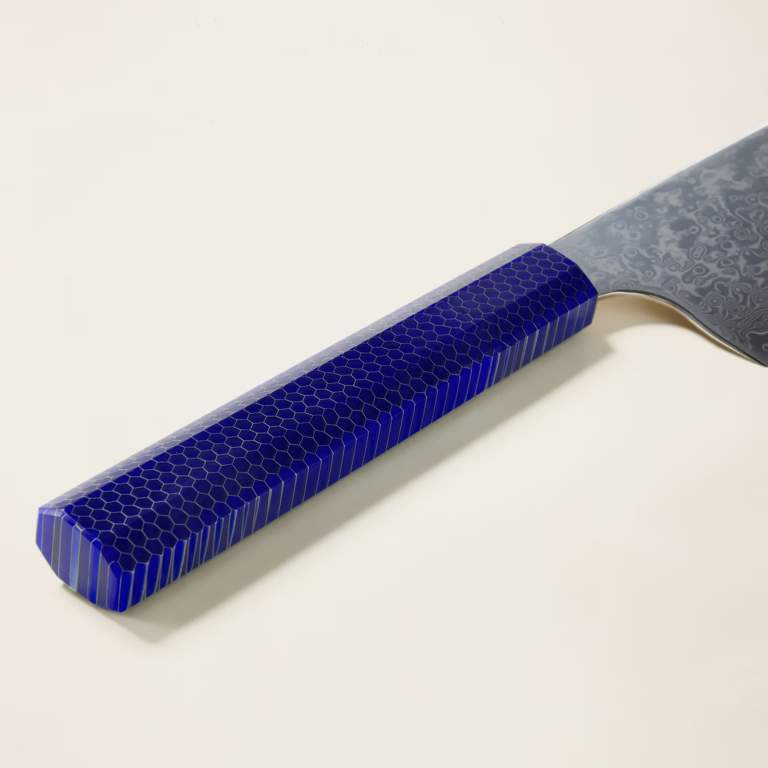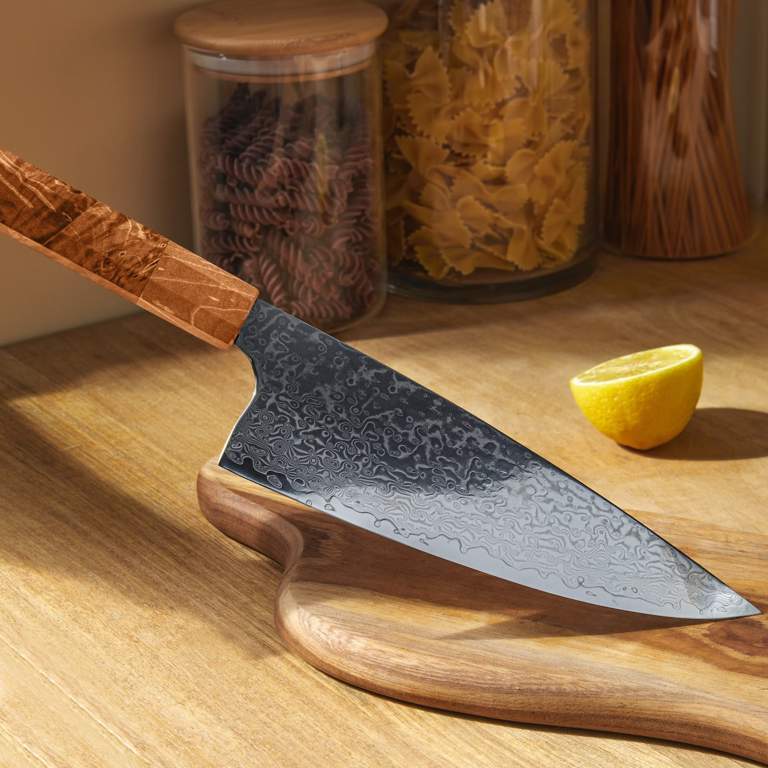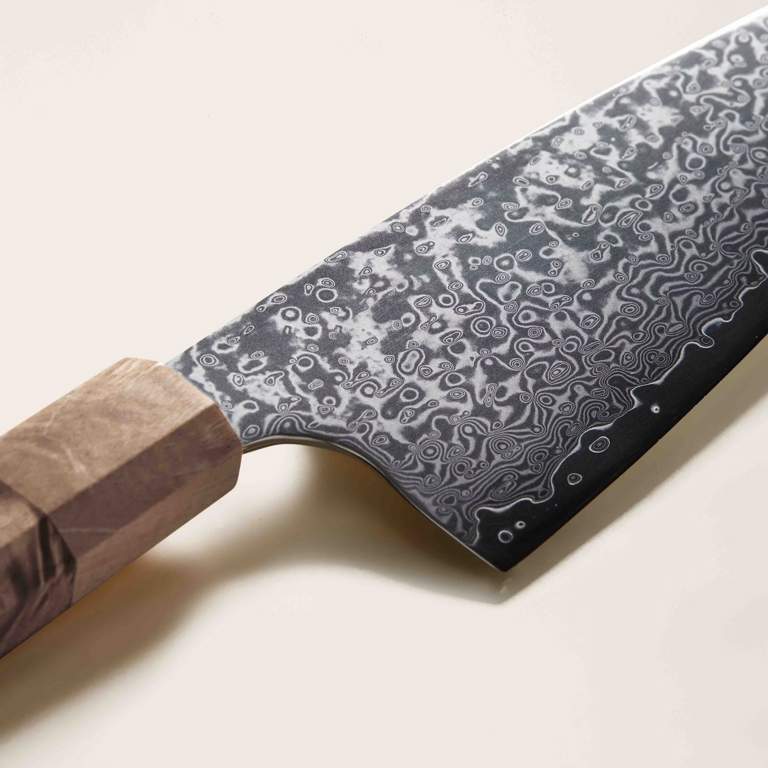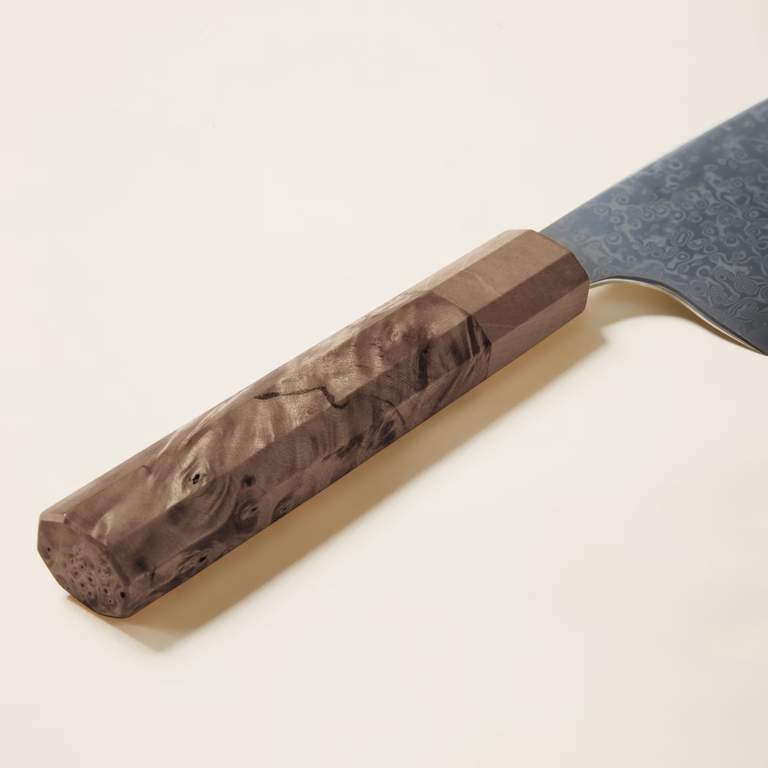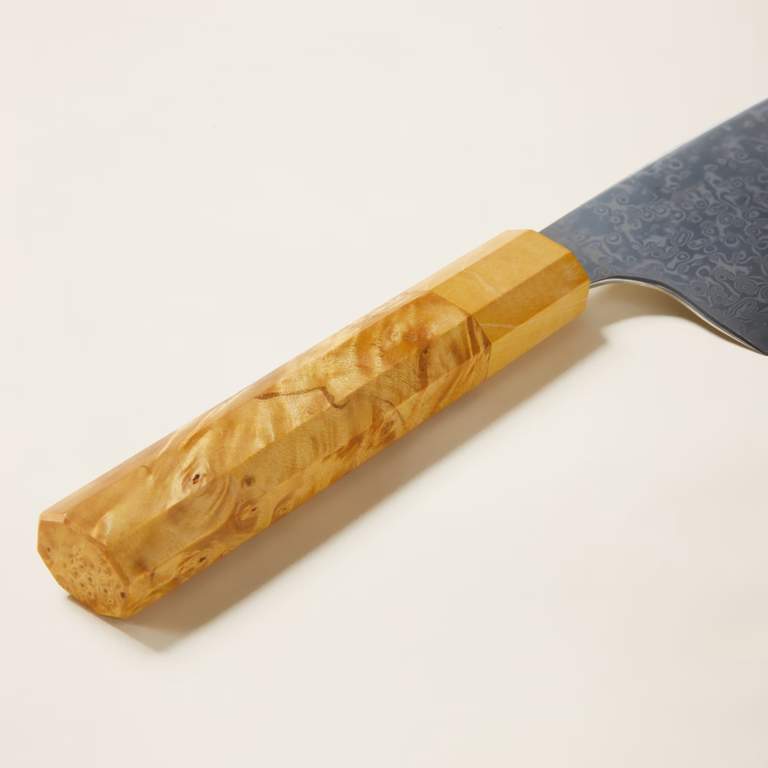Bestsellers for Japanese Knives
To understand the blade spectrum of Japanese knives, it is important to appreciate the art and history of Japanese knife making. Japanese knives are known for their craftsmanship and attention to detail. There are various types of Japanese knives, each with specific uses and differences in blade shape, length, and thickness. There are also differences between single bevel and double bevel knives, each with their own pros and cons. Damascus and carbon steel blades are popular choices, each with their own characteristics and considerations. Proper knife maintenance and care, including sharpening techniques and frequency, are essential. When choosing a Japanese knife, factors such as performance and budget should be taken into account. Italic offers a range of Japanese knives known for their quality and craftsmanship.

on Italic.com
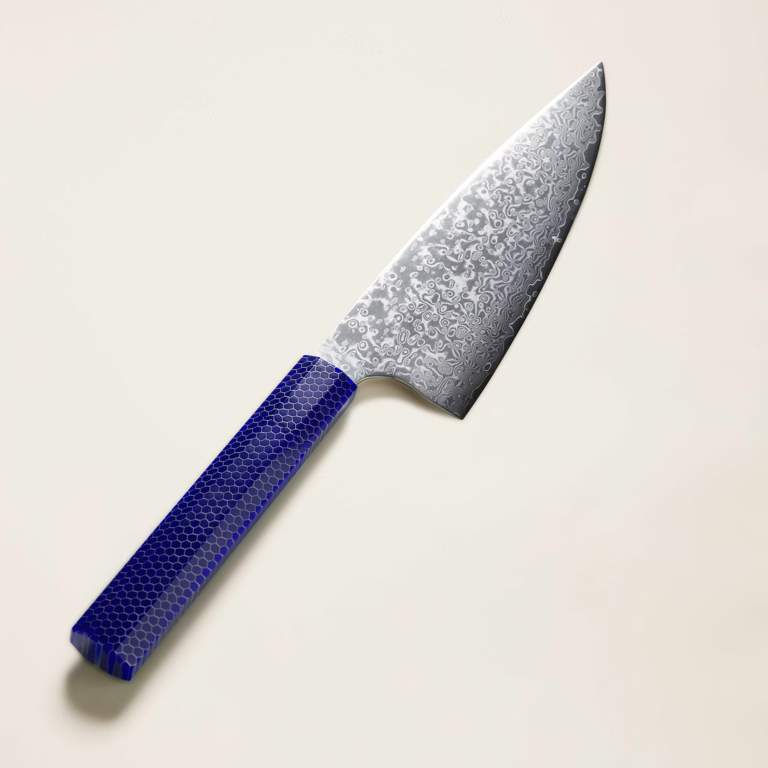
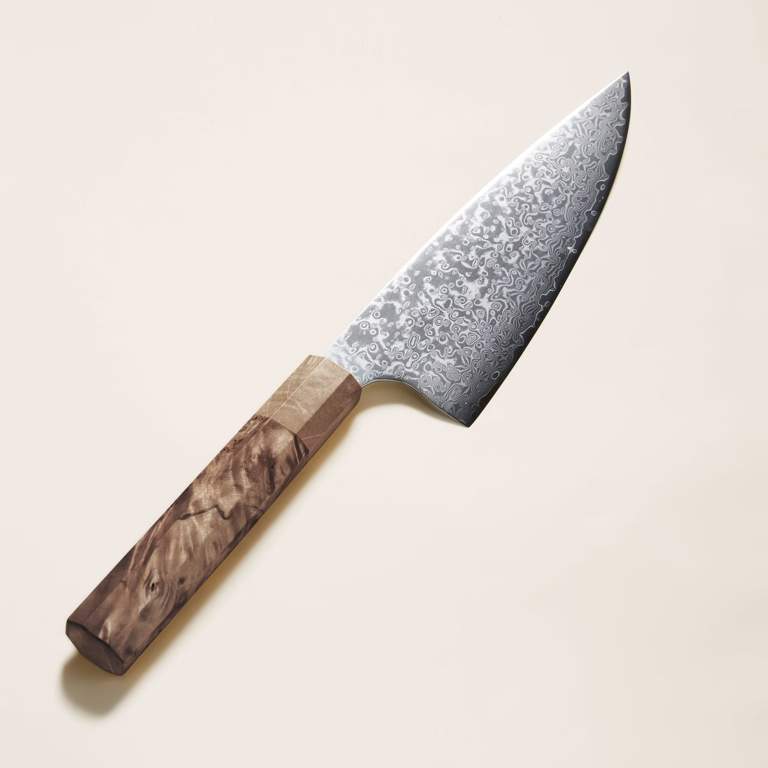
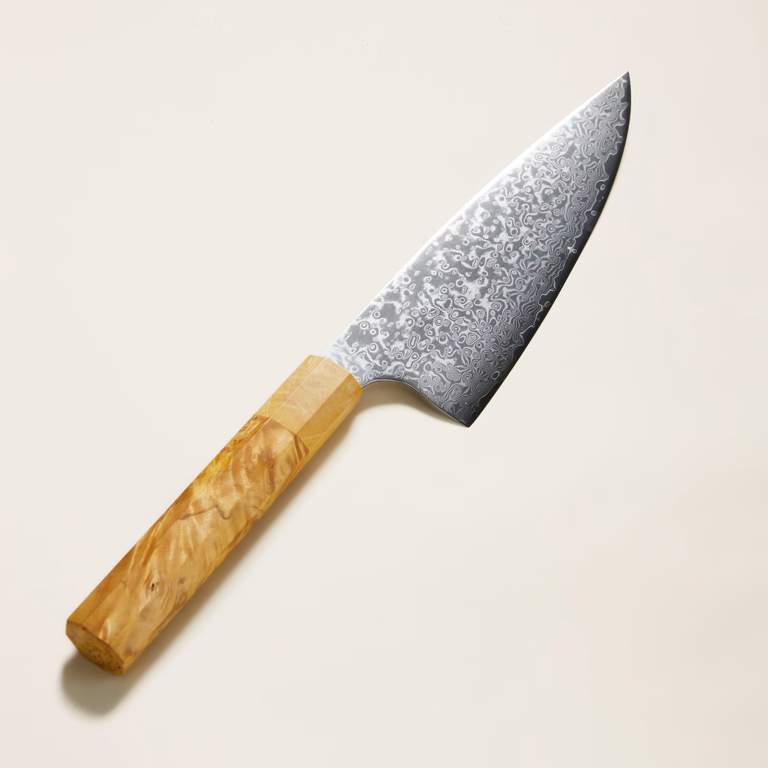
The Art of Japanese Knife Making
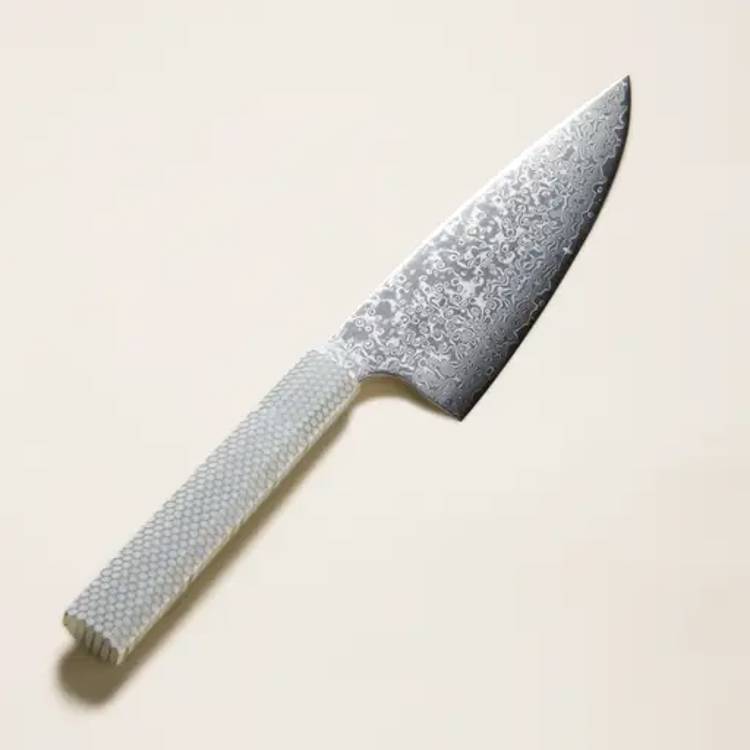
Japanese knife making has a rich history and is known for its emphasis on craftsmanship and attention to detail. The art of making Japanese knives dates back centuries and has been passed down through generations of skilled artisans.
Japanese knives are renowned for their exceptional sharpness, durability, and precision. Each knife is meticulously crafted using traditional techniques and high-quality materials. The process involves multiple steps, including forging the blade, shaping it, and honing it to perfection.
One key aspect of Japanese knife making is the use of high-carbon steel. This type of steel allows for a sharper edge and better edge retention compared to stainless steel. The blades are often heat-treated to enhance their hardness and strength.
Another characteristic of Japanese knives is their unique blade shapes. There are various types of Japanese knives, each designed for specific purposes. For example, the Gyuto knife is a versatile chef's knife that can be used for slicing, dicing, and chopping. The Santoku knife is a multipurpose knife that excels at slicing, dicing, and mincing.
Japanese knives also come in different lengths and thicknesses to suit different cutting tasks. Longer knives are ideal for slicing while shorter knives are better suited for precise tasks like peeling or trimming.
In addition to the blade, the handle of a Japanese knife is also carefully crafted. Traditional handles are made from wood, such as magnolia or ho wood, and are designed for a comfortable grip and optimal control.
To maintain the quality and performance of a Japanese knife, proper care and maintenance are essential. This includes regular sharpening to keep the blade sharp and honing to realign the edge. It's also important to clean and dry the knife after each use to prevent rust or corrosion.
When choosing a Japanese knife, it's important to consider factors such as the type of steel used, the blade shape, and your specific cutting needs. Italic offers a range of high-quality Japanese knives that combine traditional craftsmanship with modern design. Whether you're a professional chef or a home cook, Italic's Japanese knife collection is designed to meet the highest standards of performance and durability.
Common Types of Japanese Knives

Japanese knives are known for their exceptional craftsmanship and precision. They come in a variety of styles, each designed for specific tasks in the kitchen. Here are some common types of Japanese knives:
Gyuto: The Gyuto knife is the Japanese equivalent of a Western chef's knife. It has a versatile design that can handle a wide range of cutting tasks, including slicing, dicing, and chopping. The blade is typically between 8 to 10 inches long and has a curved edge.
Santoku: The Santoku knife is another multipurpose knife that is popular in Japanese kitchens. It has a shorter and wider blade compared to the Gyuto, typically around 6 to 7 inches long. The Santoku is great for slicing, dicing, and mincing vegetables, as well as cutting meat and fish.
Deba: The Deba knife is a heavy-duty knife primarily used for filleting and butchering fish. It has a thick and sturdy blade with a single bevel edge, making it ideal for making clean cuts through fish bones and tough skin.
Nakiri: The Nakiri knife is specifically designed for cutting vegetables. It has a straight blade with a squared-off tip, allowing for precise and efficient chopping and slicing of vegetables.
Yanagiba: The Yanagiba knife is a traditional Japanese sushi knife used for slicing raw fish. It has a long, thin, and single bevel blade that enables precise cuts with minimal tearing or damage to the delicate fish.
Usuba: The Usuba knife is another vegetable knife commonly used in Japanese cuisine. It has a thin and wide blade with a straight edge, making it perfect for slicing and chopping vegetables with precision.
These are just a few examples of the many types of Japanese knives available. Each type has its own unique design and purpose, allowing chefs to achieve the best results in their culinary creations. When choosing a Japanese knife, consider the specific tasks you will be using it for and select a knife that suits your needs.
Single Bevel vs Double Bevel

When it comes to Japanese knives, one important distinction to understand is the difference between single bevel and double bevel knives. This refers to the way the blade is sharpened and the angle at which it tapers to form the cutting edge.
Single Bevel Knives
Single bevel knives, also known as "yanagiba" or "usuba" knives, have a sharpened edge on only one side of the blade. This means that the blade tapers to form a cutting edge on one side, while the other side remains flat. Single bevel knives are typically used for precise and delicate tasks, such as slicing sashimi or making intricate vegetable cuts.
The advantage of single bevel knives is their exceptional sharpness and precision. The single bevel allows for a more acute cutting angle, resulting in cleaner cuts and finer control. However, single bevel knives require more skill and practice to use effectively, as they can be more prone to causing uneven cuts if not handled properly.
Double Bevel Knives
Double bevel knives, also known as "gyuto" or "santoku" knives, have a sharpened edge on both sides of the blade. This means that the blade tapers to form a cutting edge on both sides, creating a V-shaped edge. Double bevel knives are versatile and suitable for a wide range of cutting tasks, from slicing meat and fish to chopping vegetables.
The advantage of double bevel knives is their versatility and ease of use. The symmetrical edge allows for a more forgiving cutting experience, making them suitable for both professional chefs and home cooks. Double bevel knives are also easier to maintain and sharpen compared to single bevel knives.
Choosing the Right Knife for You
The choice between single bevel and double bevel knives ultimately depends on your personal preferences and the specific tasks you will be using the knife for. If you require precision and are willing to invest time in mastering the technique, a single bevel knife may be the right choice. On the other hand, if you value versatility and ease of use, a double bevel knife may be more suitable.
Italic offers a range of Japanese knives, including both single bevel and double bevel options. Each knife is crafted with attention to detail and designed to meet the highest quality standards. Whether you're a professional chef or an aspiring home cook, Italic has a Japanese knife that will elevate your culinary experience.
Damascus and Carbon Steel Blades
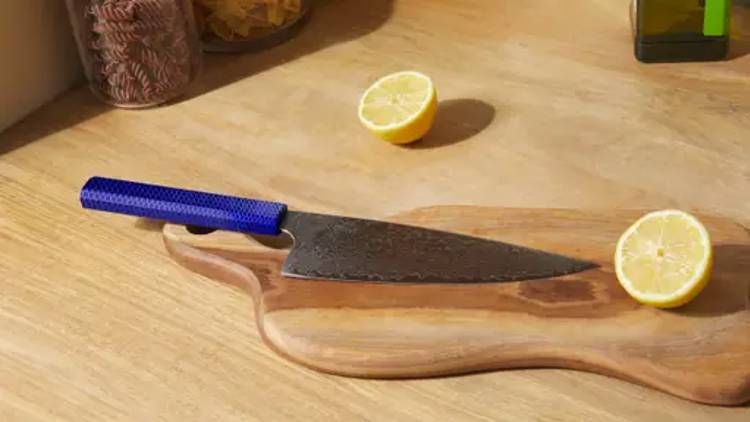
When it comes to Japanese knives, two popular types of blades are Damascus and carbon steel. Each type has its own unique characteristics and benefits.
Damascus Blades
Damascus blades are known for their distinctive patterned appearance. These blades are made by layering different types of steel together and then forging them into a single piece. The layering process creates a beautiful, wavy pattern on the blade that is both visually striking and functional.
One of the main benefits of Damascus blades is their exceptional strength and durability. The layering process creates a blade that is resistant to chipping, cracking, and breaking, making it ideal for heavy-duty tasks in the kitchen. Additionally, the multiple layers of steel provide excellent edge retention, allowing the blade to stay sharp for longer periods of time.
Another advantage of Damascus blades is their ability to hold a razor-sharp edge. The multiple layers of steel create micro-serrations along the cutting edge, which helps with slicing and dicing tasks. This makes Damascus blades particularly well-suited for precision cutting and intricate culinary techniques.
However, it's important to note that Damascus blades require special care to maintain their appearance and performance. They should be hand-washed and dried immediately after use to prevent rust or corrosion. Additionally, regular sharpening is necessary to keep the blade in optimal condition.
Carbon Steel Blades
Carbon steel blades are known for their exceptional sharpness and edge retention. These blades are made from a high-carbon alloy that allows them to achieve a razor-sharp edge with ease. Carbon steel blades are favored by professional chefs and culinary enthusiasts for their superior cutting performance.
One of the main advantages of carbon steel blades is their ability to take and hold a keen edge. This makes them ideal for tasks that require precision and control, such as slicing vegetables or filleting fish. Additionally, carbon steel blades are easy to sharpen, allowing you to maintain a razor-sharp edge with minimal effort.
Another benefit of carbon steel blades is their responsiveness to heat. These blades heat up quickly and evenly, which can be advantageous for certain cooking techniques that require precise temperature control. Additionally, carbon steel blades are less prone to staining than other types of blades, making them easier to clean and maintain.
However, carbon steel blades do require extra care to prevent rust or corrosion. They should be hand-washed and dried immediately after use, and a thin layer of oil can be applied to the blade to further protect against moisture. Additionally, carbon steel blades may develop a patina over time, which is a natural oxidation process that can enhance the blade's appearance and provide additional protection against rust.
When choosing between Damascus and carbon steel blades, it ultimately comes down to personal preference and the specific tasks you'll be using the knife for. Both types offer exceptional performance and durability, so you can't go wrong with either choice.
Knife Maintenance and Care
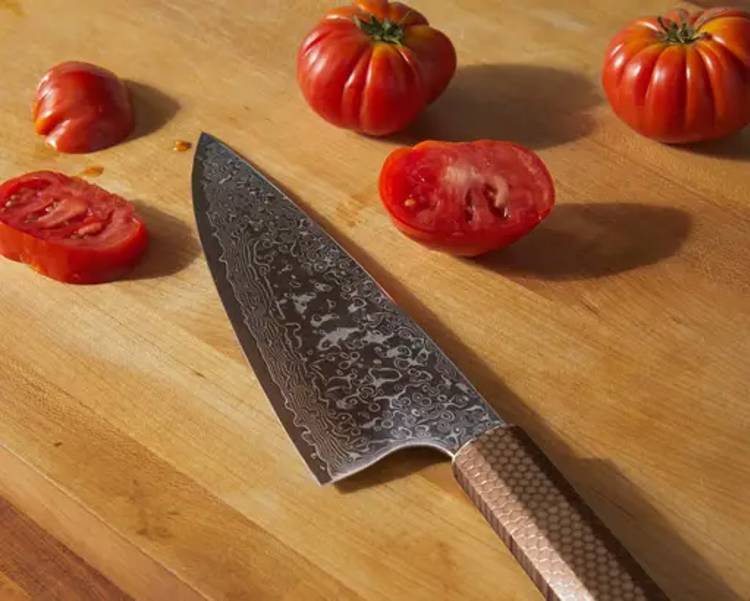
Proper maintenance and care are essential for keeping your Japanese knives in optimal condition. Here are some tips to help you maintain the performance and longevity of your knives:
Handwashing: It is recommended to handwash your Japanese knives instead of using a dishwasher. Gently wash the blade with warm water and mild dish soap, then dry it thoroughly with a soft cloth.
Avoid Soaking: Avoid soaking your knives in water or leaving them submerged for extended periods. This can cause damage to the blade and handle.
Storage: Store your knives in a knife block, on a magnetic strip, or in a knife sheath to protect the blade from damage and prevent accidents.
Sharpening: Regularly sharpen your knives to maintain their sharpness. Use a sharpening stone or honing rod to remove any dullness and restore the blade's edge. Follow the manufacturer's instructions or seek professional sharpening if needed.
Cutting Surface: Use a cutting board made of wood, bamboo, or plastic to protect the blade from unnecessary wear. Avoid cutting on hard surfaces like glass or ceramic, as they can dull the blade.
Proper Cutting Technique: Use proper cutting techniques to avoid putting excessive pressure on the blade or twisting it while cutting. This helps prevent damage and maintains the knife's edge.
Oil the Blade: Applying a thin layer of food-safe oil to the blade can help prevent rust and corrosion. Use a cloth or paper towel to apply the oil, then wipe off any excess.
Handle with Care: Handle your knives with care, avoiding dropping them or using them for purposes other than intended. This helps prevent damage to the blade and handle.
By following these maintenance and care tips, you can ensure that your Japanese knives remain in excellent condition and continue to provide exceptional performance in the kitchen.
Choosing the Right Japanese Knife

When it comes to choosing a Japanese knife, there are several factors to consider to ensure you find the right knife for your needs. Here are some key points to keep in mind:
Knife Type: Japanese knives come in various styles, each designed for specific tasks. Common types include Gyuto (chef's knife), Santoku (all-purpose knife), Nakiri (vegetable knife), and Sashimi (slicing knife). Consider the tasks you frequently perform in the kitchen and choose a knife that suits those needs.
Blade Material: Japanese knives are often made from high-quality materials such as Damascus steel or carbon steel. Damascus steel blades are known for their beautiful patterns and excellent edge retention, while carbon steel blades offer exceptional sharpness and ease of sharpening. Consider the characteristics of each material and choose one that aligns with your preferences.
Handle Material: Japanese knives typically have handles made from materials like wood, resin, or composite materials. Consider the durability, comfort, and aesthetics of different handle materials when making your choice.
Blade Shape: Japanese knives come in various blade shapes, such as curved, straight, or slightly curved with a pointed tip. Each shape has its advantages and is suited for specific cutting techniques. Consider the type of cuts you frequently make and choose a blade shape that facilitates those techniques.
Weight and Balance: Japanese knives vary in weight and balance. Some people prefer lighter knives for precision tasks, while others prefer heavier knives for more stability. Consider your personal preference and the tasks you'll be performing with the knife.
Price Range: Japanese knives can range in price depending on factors such as materials, craftsmanship, and brand reputation. Set a budget that aligns with your needs and explore options within that range.
By considering these factors when choosing a Japanese knife, you can find a knife that not only meets your needs but also enhances your culinary experience. Italic offers a range of high-quality Japanese knives that combine craftsmanship, functionality, and affordability, making it easier to find the perfect knife for your kitchen.
Italic's Japanese Knife Collection
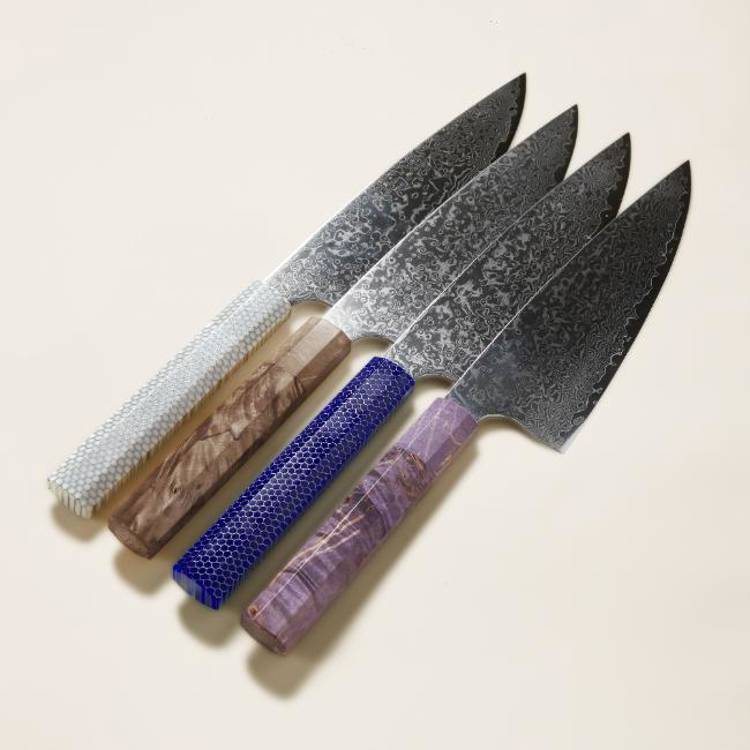
Italic's Japanese Knife Collection offers a range of high-quality knives that combine traditional Japanese craftsmanship with modern design. Each knife in the collection is carefully crafted with attention to detail, ensuring superior performance and durability.
The Kumo Japanese VG10 Gyuto Chef Knife is a standout product in the collection. Available in three different styles - Blue Honeycomb Resin, Natural Birch Burl, and Brown Stabilized Maple - this knife is not only a functional tool but also a work of art. The VG10 stainless steel blade provides exceptional sharpness and edge retention, making it perfect for slicing, dicing, and chopping. The unique handle designs add a touch of elegance to the knife, making it a statement piece in any kitchen.
Italic Buying Guide

Japanese knives are the epitome of precision and craftsmanship. With their razor-sharp blades and ergonomic designs, these knives offer unparalleled cutting performance. When choosing a Japanese knife, there are several factors to consider.
First and foremost, blade material is crucial. Japanese knives are typically made from high-quality stainless steel, such as VG10. This type of steel offers excellent edge retention and corrosion resistance. Additionally, consider the layer count of the blade. More layers generally indicate better strength and durability.
Next, consider the blade length. Japanese knives come in various sizes, ranging from small utility knives to larger chef's knives. The right blade length depends on your personal preference and the tasks you frequently perform in the kitchen.
Another important factor to consider is the handle. Japanese knives often feature unique hexagonal handles that provide a comfortable grip and excellent control. Look for a handle material that suits your preferences, whether it's wood, resin, or another material.
Lastly, consider the brand reputation and customer reviews. Japanese knife brands with a long history and positive feedback from customers are more likely to produce high-quality knives.
In conclusion, when purchasing a Japanese knife, prioritize blade material, layer count, blade length, handle design, and brand reputation. By considering these factors, you can find the perfect Japanese knife that will enhance your culinary skills and bring joy to your cooking experience. Here are some products we recommend.
Kumo Japanese VG10 Gyuto Chef Knife - Blue Honeycomb Resin
The Kumo Japanese VG10 Gyuto Chef Knife is a pinnacle of modern steel, crafted from 67 layers of pure Damascus Japanese VG10 stainless steel for superior edge retention and corrosion resistance. Its 61 HRC score ensures the knife can be used for a long time without needing to be sharpened. Its curved blade provides universal utility and its part of the limited Kumo collection which features handcrafted knives with cutting boards crafted from medium-hard Japanese Hinoki Cypress, making it the perfect combination of form and function.
- Superior quality material - The Kumo Japanese VG10 Gyuto Chef Knife is made from high-grade VG10 Japanese steel, which is known for its exceptional durability and sharpness.
- Elegant design - The knife features a unique blue honeycomb resin handle, which adds elegance and sophistication to any kitchen.
- Versatility - This Gyuto Chef Knife is perfect for slicing, dicing, and chopping a wide variety of foods, making it a versatile addition to any kitchen.
- Comfortable grip - Many users have praised the comfortable grip offered by the knife's specially designed handle, allowing for precise and effortless cutting.
- Long-lasting sharpness - The VG10 steel ensures that the knife retains its sharpness for an extended period, reducing the need for frequent sharpening.
- Easy maintenance - Users have mentioned that the knife is easy to clean and maintain, making it a practical choice for everyday use.
- Great value for money - Despite its premium features and quality construction, the Kumo Japanese VG10 Gyuto Chef Knife is reasonably priced, offering great value for money.
Kumo Japanese VG10 Gyuto Chef Knife - Brown Stabilized Maple
The Kumo Japanese VG10 Gyuto Chef Knife is a unique and luxurious piece of kitchenware, featuring handcrafted Damascus steel for superior edge retention, corrosion resistance, and durability. Its 61 HRC score makes it perfect for long-lasting use and its universal utility means it can easily slice, chop, and dice any ingredients you need. Finally, this chef's knife is part of the exclusive Kumo Collection which combines both beauty and function.
- Sharpness: Many users rave about the remarkable sharpness of the Kumo Japanese VG10 Gyuto Chef Knife, allowing for precise and effortless cuts.
- Quality Material: The knife is made from VG10 Japanese steel, which is praised for its durability, rust resistance, and edge retention.
- Handle Comfort: The Brown Stabilized Maple handle provides a comfortable grip, enhancing control and minimizing hand fatigue during prolonged use.
- Versatility: This knife is highly versatile, capable of handling a wide range of kitchen tasks from chopping vegetables to slicing meat.
- Aesthetics: Users often compliment the beautiful design of the knife. Its unique pattern and elegant brown stabilized maple handle make it a stylish addition to any kitchen.
- Balance: The knife has excellent balance, making it easy to control and aiding in precision cutting.
- Value for Money: Despite its high-end features, the Kumo Japanese VG10 Gyuto Chef Knife is considered great value for money by many users.
Kumo Japanese VG10 Gyuto Chef Knife - Natural Birch Burl
The Kumo Japanese VG10 Gyuto Chef Knife is a pinnacle of modern steel, made with 67 layers of pure Damascus Japanese VG10 stainless steel for superior edge retention and corrosion resistance. It features a Rockwell Rating of 61 HRC and universal utility, making it ideal for cutting any vegetables, meats, or breads. It is part of the Kumo Collection which includes handcrafted knives and cutting boards crafted from medium-hard Japanese Hinoki Cypress.
- Exceptional Sharpness: Many reviews rave about the Kumo Japanese VG10 Gyuto Chef Knife's superior sharpness. The VG10 steel provides an exceptionally sharp edge that cuts through food effortlessly.
- High-Quality Material: The knife is made from VG10 steel, a high-quality stainless steel that is rust-resistant, durable, and maintains its sharpness for longer periods of time.
- Comfortable Grip: Users appreciate the comfortable grip of the knife. The handle, made from natural birch burl, is not only aesthetically pleasing but also ergonomic and easy to hold.
- Versatility: This chef knife is praised for its versatility. It's perfect for a wide range of kitchen tasks, from slicing and dicing vegetables to cutting meat.
- Beautiful Design: Many users love the beautiful design of the Kumo Japanese VG10 Gyuto Chef Knife. The natural birch burl handle and polished steel blade give it a sleek, sophisticated look.
- Balanced Weight: Users note that this knife has a well-balanced weight, which makes it comfortable to use for long periods of cooking time.
- Excellent Value for Money: Despite its high-end materials and craftsmanship, users find this knife to be excellent value for money. Its performance rivals that of much more expensive kitchen knives.



